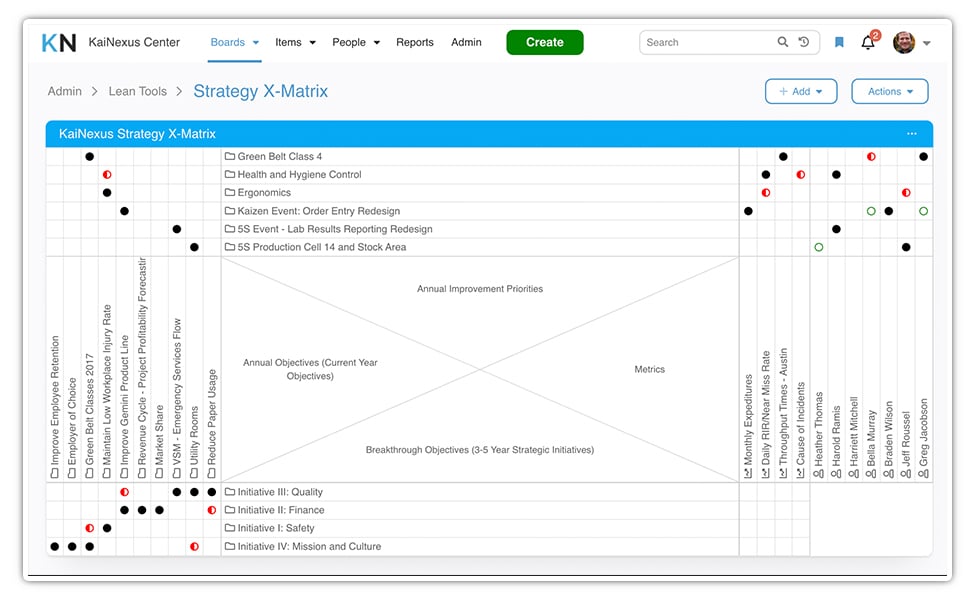 Hoshin Kanri, also known as Policy Deployment, is the Lean approach for ensuring that an organization's strategic goals are driving process and action at every level.
Hoshin Kanri, also known as Policy Deployment, is the Lean approach for ensuring that an organization's strategic goals are driving process and action at every level.
Hoshin Kanri translates from Japanese to English as "direction setting" or "management compass." It is a seven-step process incorporated into strategic planning, during which goals are communicated and operationalized through the company. The purpose of the Hoshin Kanri planning process is to improve communications and reduce waste by eliminating poor direction or unthoughtful management at any level. For this reason, organizations often use Hoshin Kanri alongside the PDSA (Plan, Do, Study, Adjust) improvement cycle.
The 7 Steps of Hoshin Kanri
Step 1: Establish the Organizational Vision and Assess the Current State
The process begins by examining the current mission, vision, and values. Next, leaders must determine if they are still aligned with the desired state. It is also essential to examine existing processes and procedures that are in place to further the objectives. Finally, consider what is working well and what needs to be reimagined.
Of course, it is the responsibility of top-level management to develop the strategic plan and set the vision. Still, leaders are more likely to achieve their goals if they get input and consensus on the strategic plan from a broad cross-section of the team. By inviting input and sharing the process of crafting the vision, leaders often get helpful information and new insights that lead to a better plan. Moreover, allowing multiple people to be part of the planning process helps foster a feeling of ownership and emotional investment with everyone involved. The Lean technique called Catchball is a helpful tool during the strategy deployment process.
Step 2: Define Breakthrough Objectives
Breakthrough objectives will cause the organization to challenge itself to stretch and grow in new ways. These goals typically take between three and five years to reach. Examples include introducing new products, entering new markets, expanding to new customer types, or adopting a new service delivery model.
Step 3: Set Annual Objectives
Annual objectives represent the accomplishments that must be achieved this year to ensure that the breakthrough goals can be reached. For example, if the breakthrough goal is to introduce a new service in three years, it may be essential to complete a market research project and define the service requirements this year.
At this point, defining how progress will be measured is critical. The Key Performance Indicators (KPIs) that will help everyone track progress against each objective should be defined. KPIs should cascade down across the organization so that every manager can track and report on the metrics that are relevant to their function. Standard KPIs help achieve organizational alignment.
Step 4: Cascade Goals Through All Levels
After the annual objectives are set, leaders and managers can start to assign department, team, and individual goals that unite the overall plan for the year. The best goals are SMART: specific, measurable, achievable, relevant, and time-bound.
Step 5: Execute Annual Objectives
Next, work on the annual goals begins. Several Lean techniques and tools can aid in problem-solving and project management at this stage. Examples include PDSA, A3 reporting, the 5 Whys, Catchball, and daily huddle meetings.
Step 6: Monthly Reviews
A common struggle for organizations is that much effort is put into annual planning, but little is put into ensuring that the plan is executed over the year. Hoshin Kanri planning addresses this with monthly strategic reviews. Assessing each person's progress toward their goals monthly helps ensure that forward momentum is maintained.
Step 7: Annual Review
At the end of the year, it is time to conduct a comprehensive assessment of the organization's progress toward its objectives. At this time, it may be necessary to adjust the goals or expected completion times. It is also the time to ensure that resources are allocated for what needs to be done in the following year.
The Hoshin Kanri X-Matrix
The X-Matrix is a powerful tool for visualizing the Hoshin Kanri strategy deployment approach.
The X-Matrix is a graph that consists of five sections that help visualize the strategic plan. It provides an easy-to-understand way to explain the relationships between annual and long-term goals and a method for dividing ownership and supporting cross-functional collaboration.
Breakthrough Objectives (Bottom Quadrant)
The bottom quadrant contains the breakthrough goals to be accomplished in the next three to five years. There are a limited number of these goals, but they are critical to the organization's strategy and set the stage for achieving "True North."
Annual Objectives (Left Quadrant)
The goals for the year go in the left quadrant of the X-matrix. The tool's design lets you connect each short-term objective to the breakthrough goal it supports.
Annual Opportunities for Improvement and Priorities (Top Quadrant)
The top quadrant contains specific known opportunities for improvement. Each opportunity corresponds with an annual objective. This provides an actionable roadmap for chipping away at the obstacles to achieving the breakthrough objectives.
Metrics to Measure and Targets to Improve (Right Quadrant)
This section contains the KPIs we discussed earlier. Defining the objective performance measures and checking on them regularly is one of the most often overlooked parts of policy deployment, so this section of the X-matrix is critical to success.
Teams and Ownership (Far Right Side)
Without accountability, strategy deployment is unlikely to succeed. That's why the far-right section of the X-matrix is used to appoint an owner to each measurement, opportunity for improvement, and annual objective. Assigning ownership helps ensure that employees become personally invested in the strategic plan.

Hoshin Kanri Planning Software
Strategy deployment and management are arguably one of the most critical responsibilities of leadership. However, it's not easy. There are many elements to juggle and multiple projects and KPIs to track. That's why software has been developed to support Hoshin Kanri as a whole and the X-matrix in particular.
Get A Holistic Assessment Of Progress
Strategy deployment software provides metrics that measure employee engagement and the impact of improvement efforts across the organization. Software makes it easy to get a comprehensive view of the organization's performance and to drill down into each department, functional area, or individual profile. The best solutions include easy-to-view graphs detailing the ROI of continuous improvement and other non-financial impacts.
Foster Planning & Collaboration
Hoshin software makes it easy for teams to collaborate and comment on each opportunity for improvement, assign tasks, and ensure that everyone is working from the same data set. A vital benefit of this type of software is that with each project, the team's knowledge repository is enhanced, leading to an accelerated pace of improvement and more intelligent decisions.
Effective Resource Prioritization
Applying resources is a crucial function of Hoshin Kanri. Collecting every improvement project and objective in one broadly-used platform helps leaders guide team members to make the best decisions about what should be prioritized. Some solutions allow you to create a weighted scoring system that lets team members at every level evaluate the priority, risk, and complexity of any proposed project based on predetermined criteria.
Hoshin Kanri is a proven method for achieving transformative breakthrough objectives. It requires active involvement and engagement at every level of the organization. It isn't easy, but it is supported by several Lean tools, the purpose-built X-matrix, and improvement management software. If your organization is ready to take strategic planning to the next level, Hoshin Kanri is an excellent choice.




Add a Comment